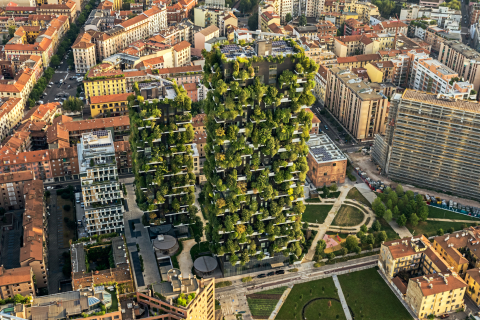Stefano Boeri Architetti
Elettra Zadra
press@stefanoboeriarchitetti.net

Urban Forestry: the Future of Cities Even in the Arid and Torrid Areas
- MILAN - Thursday, 01. April 2021
- AETOSWire
The insights from the architects who designed the first vertical forest, the global inspring model of urban forestry
(BUSINESS WIRE)-- “We have entered a new phase of human history, in which we will finally see a new alliance between forests and cities, two environments that our species has always kept separate as an expression of, respectively, one of the maximum of artifice and the other of the maximum of naturalness. Trees and woods will no longer be just a decorative presence or an environment to be circumscribed in protected areas but will become an integral part of the sphere of life of millions of citizens of the world. Defending forests, foresting cities and growing new Forest-Cities: these are the great challenges to be faced immediately, all together, if we want to stop Climate Change”, this has been stated several times by the architect and urbanist Stefano Boeri, founder of the practice Stefano Boeri Architetti and the author of the globally renowned Vertical Forest in Milan that contributed to the development of the concept of Urban Forestry worldwide. The architect Boeri has been involved in many international working tables and committees from the Urban Forestry of Milan to the Great Green Wall of Cities presented during the last United Nations Climate Action Summit. The project aims to build 500,000 hectares of new urban forests and 300,000 hectares of natural forests close to 90 cities stretching from Africa to Central Asia to be cultivated and maintained by 2030.
Climate change is increasing the exposure of city-regions to droughts, heat waves, extreme winds, floods and landslides, affecting hundreds of millions of people. Nature-Based Solutions and Forest-Based Solutions, support adaptation to climate change by cooling the environment, protecting soils, preserving river basins and providing forest products to urban dwellers. Adopting strategies that combine technological innovation with locally adapted and climatically appropriate Nature-Based Solutions, can help cities and communities mitigate the effects of climate change and provide positive long-term social, environmental and economic benefits.
If indeed it is true that the cities of the world produce about 70% of the CO2 present in the atmosphere and that forests and woods absorb 40%, increasing wooded areas around and within the world’s cities would multiply the capacity for resilience of urban areas and would drastically reduce the production of CO2 thanks to plant-based photosynthesis.
Within the framework of Urban Forestry vision, the international team working with the architect Stefano Boeri, strongly believe in the development of specific design strategies - such as Planted Roofs and Walls - that will represent a solution of great challenge, ambition, and success for the greening of various metropolises into arid environment or torrid climate.
The research department of Stefano Boeri Architetti is leading the international debate and development of green and sustainable urban design in Europe and in many countries worldwide. Its contribution to the ecological and ecosystem-based debate and its leading role in the urban and peri-urban ecological regeneration movement, adopting a nature-based approach, places the whole team at the forefront of both the academic and practical development of enhanced, mixed-use Nature-Based Solution design projects.
What about the most arid and torrid areas in the world? Which opportunities has the Urban Forestry in these places, like the Saudi Arabia and cities as Riyadh? To foster greening in arid environments is not a simple task but there are several examples showing methodologies and techniques to achieve excellent results in arid and hyper-arid climates that Stefano Boeri Architetti has developed for specific cases as for example the Vertical Forests in Cairo: the towers will measure 30 meters both in height and width and will host 350 trees and more than 14000 shrubs and perennials belonging to 100 different species, one third of the genera living in the whole Greater Cairo. The total green area will overcome 3600sq.m. equal to the building footprint. The three new vertical forests, the first ones in Africa, will be energetically self-sufficient and will absorb about 7 tons of carbon dioxide in one year and produce 8 tons of oxygen.
The optimized integration of the continuum collection, storage, use, and management of water resources is crucial in implementing any kind of green space. This aspect appears even more consistent whenever the green target deals with nature-based solutions concerning artificial structures and infrastructures. A conscious use of water resources and its management can make the difference to reach the objectives proposed by the Climate Change Summit. The green implementation systems by Stefano Boeri Architetti are: Biodiversity-xerophilic green roofs characterized by the presence of native species adapted to drought habitats (rocky formations micro-habitats vegetation) to allow the minimization of maintenance operations - almost need no irrigation systems; Biodiverse vertical green walls, providing a wider range of vegetation, from trees to shrubs and perennials that will benefit from recycled grey water from the building as a unique source of water; Bioactive green roofs/walls in terms of remediation of grey water. In this sense, the plants will support the last phase of water recycling; Functional and structural diversity of plant cover: roughness complexity and eco-physiological diversity of plants improve the direct and indirect environmental benefits for water cycle, gases exchanges and balance, and soil health.
These systems will create a sustainable, strong, long-lasting green infrastructure that will mitigate the urban heat island effect, assure the insulation gains for buildings facades and roofs reduce storm-water drains and air pollution. Living roofs and walls become active components of urban landscape infrastructure.
The choice of native plants for the landscaping, for green roofs or walls, will make local wildlife thrive and will create a healthier place for the users and the community. Lawns and the ubiquitous bark-mulched landscapes are notorious for requiring profuse amounts of artificial fertilizers and synthetic chemical pesticides and herbicides. The traditional suburban lawn, on average, has 10x more chemical pesticides per acre than farmland. Landscaping with native plants can mitigate climate change.
Nature-based solutions can favor sustainable urbanization, restore degraded ecosystems, improve climate change adaptation and mitigation, and help risk management and resilience. Furthermore, by reshaping the urban environment, Nature Based Solutions can enhance inclusivity, equitability and livability, regenerate deprived districts, improve citizens’ mental and physical health and quality of life, reduce violence, and decrease social tensions through better social cohesion particularly for most vulnerable groups e.g. children, elderly and people of low socio-economic status.
https://aetoswire.com/en/news/urban-forestry-the-future-of-cities-even-in-the-arid-and-torrid-areas
